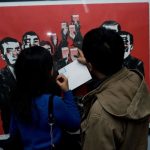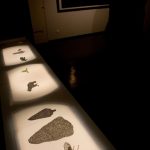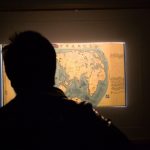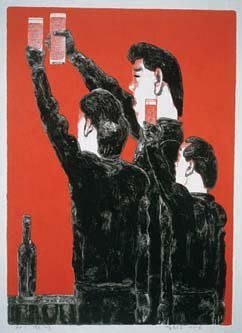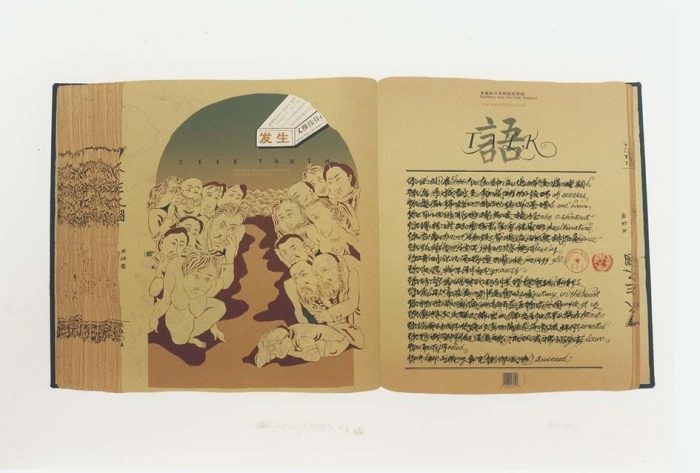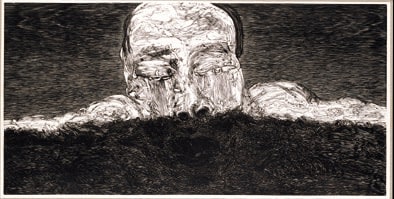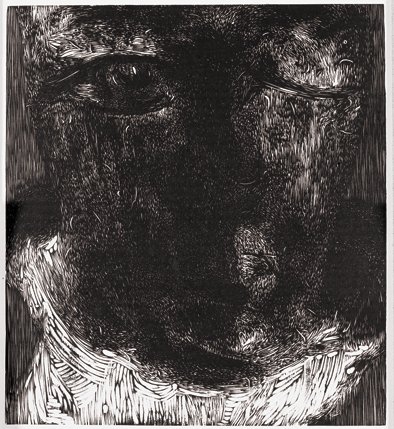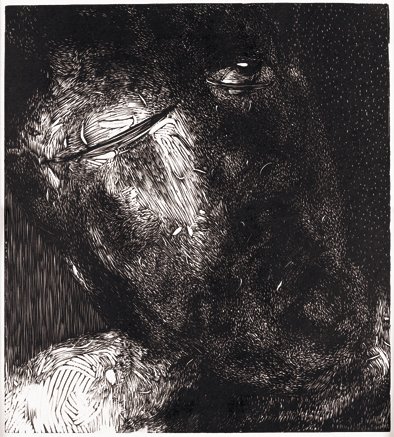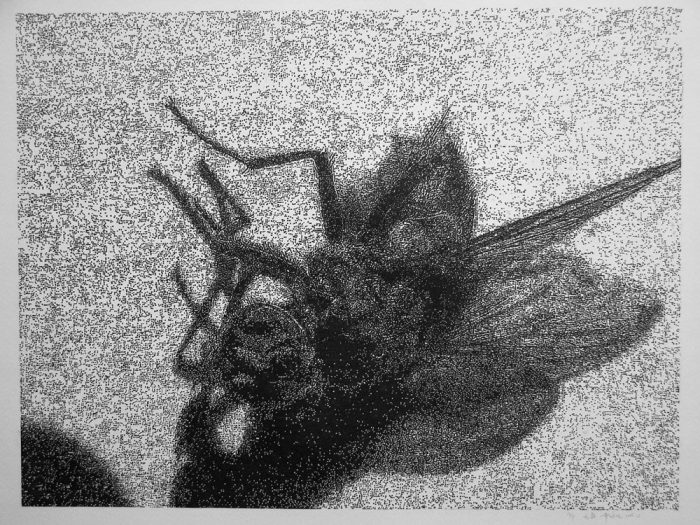Trace·Image – the prints exhibition of five artists
2009.03.14 – 2009.05.20
Press Release
Possible Evidence
Zhou Aimin
Under the superficial prosperity, the Chinese contemporary prints are hiding its own development crisis and challenges. Mixed conception of “create prints” and “copy prints”, the confusion between the artworks and printings, are the most remarkable problems of the contemporary prints. Although the mixing and confusion are the features of the post modern art, and breaking through the boundary brings certain new opportunities and promotes the concept and forms of creating prints to the richness and pluralism, we have to face and clear all the fake prosperity made by those rooted non-art reasons. Prints is not a by-product of contemporary art, but rather that the inherent attributes makes it maintain the natural agreement with the lively image time, and make it become a contemporary art media with strong expression. The works of the five participated artists, Su Xinping, Hong Hao, Yang Hongwei, Shi Xinji, Cao Peilun, are totally different in art opinions and creation techniques, but they all without exception think about the art based on the foundation of the prints. They complete their works with silkscreen, lithograph, woodcut, not just to regard copying the image as the result of visual performance, the thought and spirit desire are internalized in the whole process of drawing, carving, printing. There are not only the successful artists who have great influence, but also the freshmen in these five artists. The prints exhibition of five artists presents the creation appearance of each artist. Meanwhile, it makes us re-examine the spirit and cultural values of Chinese contemporary prints between the trace and the image.
Consumption makes daily life full of the holiday-like celebrations. Banquet is a general performance of the rich society, and also the characteristic form of Chinese culture. It gathers a group of people with specific social relationship and identity. The relationship of “comrade” which is decided by the political ideology previously has been replaced by reality benefit community — the mutually beneficial relationship by consultation and reaching conspiracy. In fact, this relationship exists not only in the commercial activities, but also in the inter group association of politic economy and culture, even some private actions. In the series “comrade”, Su Xinping starts from the appearance of the life, then gets deeper to the cultural thinking by showing the scene of banquet. He uses the simple technique of prints, rejects the verbose detailed description, and summarized the picture into two colors: red & black, to emphasize the facial expression and the movement of the figures. Simple pure technique is not only the form, but also the concept expression. At least, he keeps his own ways of creation and characteristics on this spot — he takes out certain life figures from reality by a succinct and intensive way, so that make the figures become a metaphysic objects of spirit examine. Toasting each other, smiling, farewell — all these intimate manners cannot place people in safety, stability, satisfaction and happiness. What they embody is nothing but a series religious ceremony of “concern” in this expense society. In the myth of mutual concerns, the autonomous, independent individuals are vanishing and have been replaced by flexibility and fluctuation of individual value in “comrade relation”, to make it tend to a purpose, which means “the individual is no longer the origin place of self-value, he is just the multi-relational terminal in the unstable relationship” (Jean Baudrillard). The expense society produces the goods and wealth fast, so does the social relationship. When “comrade” toasting each other, they are consuming drinks, also the relationship — a temporary relationship which is produced and disappear fast simultaneously.
???????? Hong Hao is extremely sensitive to the image technique. He uses the modern digital technique, or prints technique in another word, to reproduce in a high speed. The pictures were born in a process of simple accumulation and addition. Those subjects in the pictures extends unlimited, without beginning and ending, which compose the scene of subject. Along the East 3rd Ring Road in Beijing, these scenes are shown in form of advertisement light boxes. They are dazzling under the light, and compose a growing metropolis scene with the crowd in central area of CBD. In fact, these digital reproductions can be seen as an extension of creating the “Selected Scriptures” series by using silkscreen. Both of them are same on the creation theory, which transfer the reproduction technique into the expression of the art concept. If digital reproduction is a kind of post–industry method, silkscreen reproduction is the typical industrial method. “Selected Scriptures” series puts forward queries, even a subversive judgment, about the existence and value approval by means of using mechanical printing method skillfully. This is just what Hong Hao said, “in a movement which has a loophole can be used, people find a secret: the printing should be the medium of knowledge and truth, but it is possible to be distorted under its sacred surface”. He reproduces the “Scripture” by means of silkscreen printing which is joking but clever. It allows people doubt the original knowledge, and at the same time, be aware of that the confusion and copy can be considered as a cultural strategy, and become the early signs and condition of some certain new culture.
???????? As a mature steady artist, the artworks of Su Xinping and Hong Hao are inclined to the deeper thinking of the social and cultural condition. but the three young artists: Yang Hongwei, Shi Xinji, Cao Peilun, prefer portraying the self-feeling from inner-mind. Besides, all of them choose the most traditional woodcut prints as the creation medium. In terms of technique method, woodcut is the most simple and pure type in the printmaking. But the simple obsolete technique doesn’t mean the superficiality and conventional pattern, because the witness of art can make the single object full of variable: to get the richness from the supreme simplicity. Maybe this is one of the reasons why woodcut can keeps its charm. and the various character artworks of Yang Hongwei, Shi Xinji, Cao Peilun, just prove this point.
???????? We are experiencing an era of image world. The pictures build a true world rather than the world’s factuality produce the images. So the factuality of the world can not activate the creating passion of the artists any more, especially for those young artists. These young artists are no longer like their predecessors who break though the reality surface in order to exhume the existence of deeper truth. In their opinions, the surface is the deeper truth. Shi Xinji obviously belongs to this type. His woodcut mixes his personal growth and background with the characteristics of dexterous and unrestrained. Affected by comics and martial arts novels, Shi Xinji combines imaginary world and the real feeling together. The figure he created shakes off the limitation of rules. In his emotional and interesting world, those insects, animals, plants, even a tiny spot, all have lively lives. Although these fantastic images are dissociated from the reality, they still carry the real emotion which is more strong and stirring. No matter indulging passions or being lonely, the image world is just like a stage for a single person. All mortal beings are the embodiment of free human nature. As far as being concerned, Shi Xinji’s works make people find a special leisure spirit territory in the world which is filled with rational plans.
???????? In art creation, the performance is always tend to simplify so that the emotion is more concentrated and strongly through the language enrichment. The Germany Expressionism reflects more clearly on this point. And Yang Hongwei obviously gets benefit from this traditional woodcut. But compare with the Germany Expressionism which has strong subjective desire and political emotion, Yang’s woodcut appears more private and personalizing. As far as Yang Hongwei is concerned, wood plank can be seen as a dark gloomy cave. And he is just the explorer. When he holds the carving knife in his hand, his spirit is totally following the magic summons from the deep cave. Varying the carving methods repetitively is not a dazzling technique, but a means of make the floating knife and the magic power has the same tendency. Although those figures he found in the dark cave are a little bit bizarre, the flashing eye sight and the bewildering light are sufficient to cause heart thump. When watching his works, we seem to hear a voice of Max Beckmann with hurried breath shouted:”Self is a great veiled mystery—it burns strongly inside of me, my mouth closes tightly, my will is calmer. Catch this terrible trembling monster, suppress, and clutch at its throat.”
Yang Hongwei and Cao Peilun are accustomed to create huge woodcut works. Comparatively speaking, Yang Hongwei’s carving method is various, and Cao Peilun’s is deliberate and delicate. Cao Peilun projects his self-psychology onto a specific real figure. He carves out a huge fly in ways of subtlety realistically. It’s hard to say whether this kind of figure which seems to peep under microscope has clear significance. Perhaps it is not aim at revealing the meanings. What it appears is a vision, a vision with psychological pressure. Those accustomed happy visual aesthetics has been blocked. His “Hello, Mr. Duchamp” exceeds the knowledge people used to know. In terms of the huge size, his works carry on a kind of extraordinary technical strength. Duchamp puts two bushy of moustache on the face of Monalisa, while Cao Peilun places the post-modern classic of the altar onto his works. This kind of attitude is not so much the imitation to Duchamp as a ornament. He is conscientious about every detail, and has no intention of letting himself bear a heavy responsibility of art history. He is still young and he has no need to let the heavy significance of art history squeeze the fresh feeling, because the art existence is not based on the logic of art history, but the bright heart.
???????? The Prints Exhibition of Five Artists appears a fresh look of creation in the art reality. Chinese modern prints have become the “Pioneer” in the trend of social and cultural revolution. But this characteristic shows a situation of decline recently. The real difficult position of Chinese prints art mainly reflects into two aspects. First, academy prints is limited to the technical means and language form. The prints technique is specialized step by step while the creative spirit becomes pale and weak. The virtuosity covers the ideology and cultural value so that the exquisite skills are falling into the void. In addition, prints are prompted by the simple tools and purpose awareness under the promotion of social needs and art industry. Although there are a lot of various prints exhibitions with a word “contemporary”, they have already lost the instinct and character of creation. And the prints have become the advanced methods of copy”Chinese Contemporary”. Just because of the dilemma, these five artists who are in various situations make a great contribution to breaking out the dilemma in ways of their art experience and creation tendency. In one hand, they carry on the rigorous spirit of academy creation and are very familiar with technique language; in the other hand, they combine the creative thinking and the tide of contemporary social culture, insist on exploring personal art language, and pay close attention to the feeling of real life and contemporary art experience. They persevere the noumenon of prints, and expand the capacity of the spirit of prints art and contemporary character at the same time.
Though it is not easy to generalize the creations of these artists in a unity theme or gist, their various prints can just be considered as the sample of contemporary arts coexistence. The final gist of various prints creations is to make prints intervene into contemporary life and become a significant part of present-day humanistic creation. Conversely, if prints are limited by material and professional language research or even confuse and misuse the concept of its function of reproductive, the development of prints will be narrow day by day, and strangle the life of art in final. Prints is the common way of creation for the five artists. Their art thinking are extended into different fields from this original point, such as social, cultural and individual consciousness. Therefore, their creations provide a fresh and remarkable evidence for further development of prints art.
